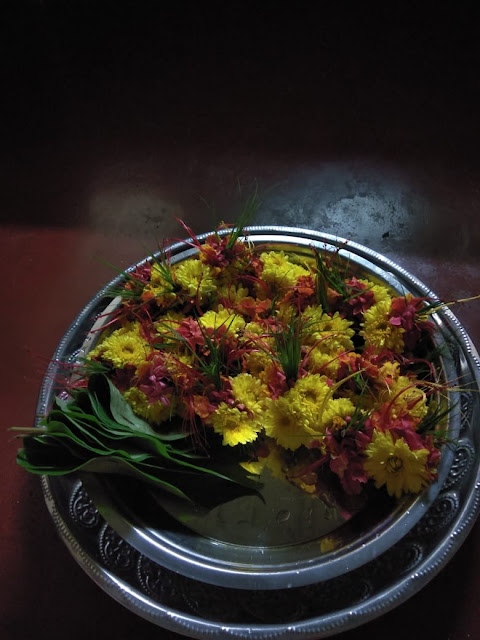I have again posted about Chudi pooja as I have updated with few photos and information in one post.
Today being the last day of Choodi I
thought I must not delay in posting this so I am posting the Pineapple Pudding
or Pineapple Sheera that I made for Shravan
Choodi Pooja, is performed during
shravan month of every year on Fridays and Sundays by married ladies. A newly
married woman performs her first Choodi Pooja in the presence of many elderly
women, separately in her husband’s home and her parents' home.
The story behind Choodi pooja goes like this, It is woven around the demon king Jalandhara. His wife Vrinda devi was an embodiment of chastity and fidelity her qualities had prevented the protector of the worlds Maha Vishnu from vanquishing the demon king Jalandhara and break his hegemony over pious people of the world. So Maha Vishnu appears before her in the form of Jalandhara when the demon king had gone out for official engagements. Maha Vishnu then makes his move and outrages Vrinda’s fidelity towards her husband. Having the last umbrella of protection over Jalandhara Vishnu later engages him in a war and defeats him and saves the world from falling under the rule of demons.
A women will be dressed up in saree and arrange her pooja thali with -chudi flower,haldi kumkum,little uncooked rice, Prasad for naivedya freshly prepared at home, veedo(arecanut/betel nut piece in betel leaves), insence stick, arti and a steel pot filled with water.
A tulsi plant has medicinal properties capable of purifying the surroundings.
The door step (Humboru/Hosthilu) are decorated with chalk designs (Rangoli or Humbraa Chalk). This is how i decorated here with sticker and I have painted a little as if I draw with the chalk there is nothing visible.
First, with a Divvo(lamp) is kept in front of tulsi then,Haldi and Kumkum is applied to Tulsi as a symbol of womanhood,water is given to the Tulsi plant with tambiyo(small pot)and also consumed by the one offering the pooja (Aachamana), Agarbatti is shown and then the naivedya is offered( any sweet which is prepared at home or any fruit or coconut) (but any thing made of rice is not offered), followed by Soorya Namaskaara(Sun Worship).
Then Chudi is offered to Tulsi and aarati (Flame) is shown to Tulsi. Later, they offer pooja and Choodis to the Door step (Humboru). Finally, all the gods within home are offered similar pooja and Chudis.
There are no mantras and no shlokas
but the married ladies alone can perform this pooja after a fast in the
morning. Among the married ladies, those who are close in relation(elders) but
far away by location are remembered and a mini-chudi will be sent by mail/post
with a little kumkum (which I am going to send to my amma and mayi(mil)). And
they will send a similar chudi with their blessings. Thus in the
month of Shravan our chudis will cross the seven seas and travel to far off
lands
The remaining Chudis are
offered to elderly women by the younger ones. They all wear the Chudi in their
hair locks. In return, the elders also present a choodi to the younger ones.
For the next four weeks or eight days, GSB women will be busy, going from house
to house, offering chudis and There is also a custom, that the wife
offers the first Chudi to her husband along with a worshipped coconut Veedo
(beetle leaves with Arecanut), believed to bring happiness and goodwill for
married women and husnabds long life.
Superstition apart,
Chudi Pooja is symbolic where a woman feels complete within her married life.
This pooja also gives scope for women to keep social contact with their
families at least once a year!
A standard Chudi requires many
flowers and herbs to be collected, as mentioned here -
1. Ratnagandhi
2. Ratha Pushpa
3. Gauri Pushpa
4. Kaaylya Dolo (Crow's Eye)
5. Anwaali
6. Aarati Pushpa
7. Kangani Pushpa
8. Shanka Pushpa
9. Mithaai Pushpa
10. Majra Nankut(Cat’s Nails)
11. Wild Grass (Dibrankoru)
12. Plantain yarn (Vaayu) for
tying
Earlier, the flowers were easily available
but due to non availability of these flowers the ladies in the Gowd Saraswath
Brahmin community do scout for local varieties of flowers. Women make nine
chudis and gives it to the other women in her family or locality.
To cater to the present day needs,
readymade 'chudis' are now available in the market.




















Comments